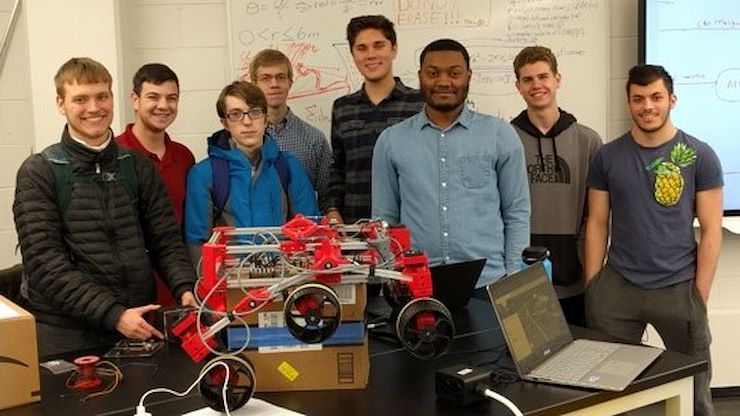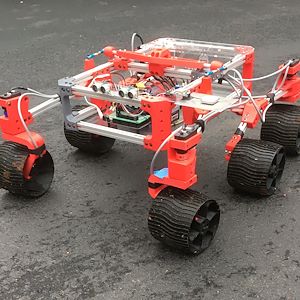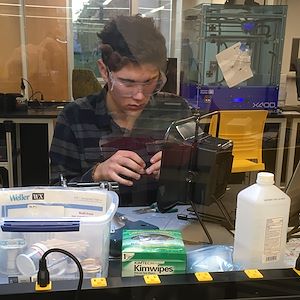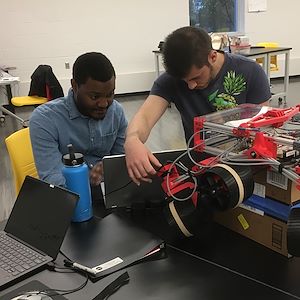
Students at Montgomery County Community College finished building three autonomous NASA Mars Curiosity Rovers despite the COVID-19 stay-at-home order.
In the face of the COVID-19 global pandemic, a team of students at Montgomery County Community College managed to nearly complete a yearlong, out-of-this-world independent study that would surely make the folks at NASA proud.
The mission for the team was to design and build from scratch a scale NASA Mars Curiosity Rover that was similar to the ones blasted off into space to study the Red Planet. The twist on the project was the machine had to be able to autonomously travel anywhere on land, provided it didn’t cross a road or go through a building. The test would be to see if it could venture from the Science Center to Parkhouse Hall on MCCC’s Central Campus in Blue Bell, while maneuvering around any obstacles in its path.
Students Paul John Balderston, Noah Williams, Ezra Galapo, Salvatore Sparacio, William Pastor, Nicholas Gahman, Corey Shive and Jaden Weed were recruited to the project, based on their previous expertise in mechanical, electrical and computer engineering.
Galapo and Williams, an MCCC graduate, are students at Temple University, while Gahman and Shive are dual enrollment students and Weed is a student at North Penn High School.
Together they collaborated and built three rovers, each with a different object detection
system, to see which would work best for the mission. Two of the three rovers were
completely finished by the end of the spring semester. Unfortunately, the team was
unable to finish the third rover in time due to the COVID-19 pandemic.
The project was part of a five-year grant program from the NASA Pennsylvania Space Grant Consortium, which has allowed MCCC students to participate in innovative science projects. Past projects include the creation of a quadrotor helicopter that students operated remotely and taught to navigate the skies; the development of a motor test bench, which measures the efficiency of a small motor; and the creation of a recovery device for a high-altitude balloon used by Temple University to film the total solar eclipse for NASA in near space altitude. Students also equipped a 1730 water mill in Bucks County that’s still in use with Internet of Things (IoT) sensors to be able to interact with smart computers, and they attended a rocket launch with Temple University at the NASA Wallops Island facility in Accomack County, Va.
The rover project began in the summer of 2019.
“This is such a cool project,” said James Bretz, Dean of Science, Technology, Engineering
and Mathematics (STEM). “It shows our students how a big-time research project works.
What it’s like to work on a team in a professional environment. You have to finish
the project, meet the deadlines. The innovation is awesome. Every project has been
innovative and unique. It’s fascinating for students and challenges them in a way
they don’t get challenged in the classroom. These students are really talented.”
Bretz explained the mechanical design plans for the rovers were found online and the team used 3D printers to construct pieces that connected aluminum beams to make the frame.
Each rover’s navigation was run through a microcontroller, which is like a simple, low-powered computer, said Bretz.
“Standard navigation systems use microcomputers, which are heavy. We tried to use microcontrollers,” he said. “They’re small and inexpensive. Also, microcontrollers require basic coding, so you don’t have to use all of computing power to navigate. You can use the cargo space and computing power for something else.”
Each rover was designed with its own unique object detection system. The first incorporated ultrasonic sensors to measure distance with reflected sound, like radar detection. The second rover featured a Lidar sensor, which measures distance using light from a laser. The third rover featured an optical sensor, which uses two cameras mounted to the front of the rover and a field programmable gate array (FPGA), to process the video from the cameras and detect obstacles.
“Anything that prevents the rover from getting to a destination is an obstacle,” said Williams. “The rover follows a straight line. It uses GPS. It needs to know what direction, when to turn, and how far away an object is.”
The rover team was on track to have all three machines completed by the end of the spring semester. Then the COVID-19 pandemic broke out and unfortunately put a wrench in those plans.
“We started last summer with just general brainstorming, testing designs, components
and what we wanted to do,” said Balderston. “We were making pretty good headway until
mid-spring semester. Then everything went remote.”
Students would no longer have access to the state-of-the-art laboratories on Central Campus, which house the 3D printers, laser cutter and other pieces of advanced equipment they’d need to complete the project.
“It was definitely more challenging during the second part of the spring semester since we were working from home,” said Galapo. “Because we were able to meet up as soon as the pandemic happened, each team member was able to get the pieces they needed. So from the mechanical and electrical side, we were still able to mostly complete the rovers. We just couldn’t give them to the computer scientists to debug it and try to get them to work.”
The team received overwhelming praise from MCCC faculty and others at area colleges and universities, who evaluated their efforts during a final presentation in May.
“This project needs to continue,” MCCC Engineering Professor William Brownlowe told the team directly during the Zoom video conference call. “Hopefully you won’t stop ruminating on this project. Come fall, you’ll take over ownership. It’s the students that drive these things not the advisors. I applaud your efforts and look forward to seeing you back in the labs and back on the project. Recruit your peers.”
“I am so proud of you. I am amazed at how you pulled this together. Your perseverance and dedication is heartwarming to see,” said Temple University Associate Professor of Engineering John J. Helferty. “You’ve got to be proud. We’ve all been through this COVID-19 thing for the last two months and it is a testament to your dedication that you were able to move forward.”
“It is quite a challenging, crazy situation you’re facing,” said Joseph Oakes, Penn State Abington Program Chair IST Computer Science. “You didn’t make excuses and got the job done. Hopefully in the future you’ll reach out to me.”
Each team member said they felt they learned a tremendous amount from this project and was proud of what they were able to accomplish.
“I feel really good about what we did get done even though it wasn’t as much as we had planned originally,” said Pastor. “It’s still a success.”
